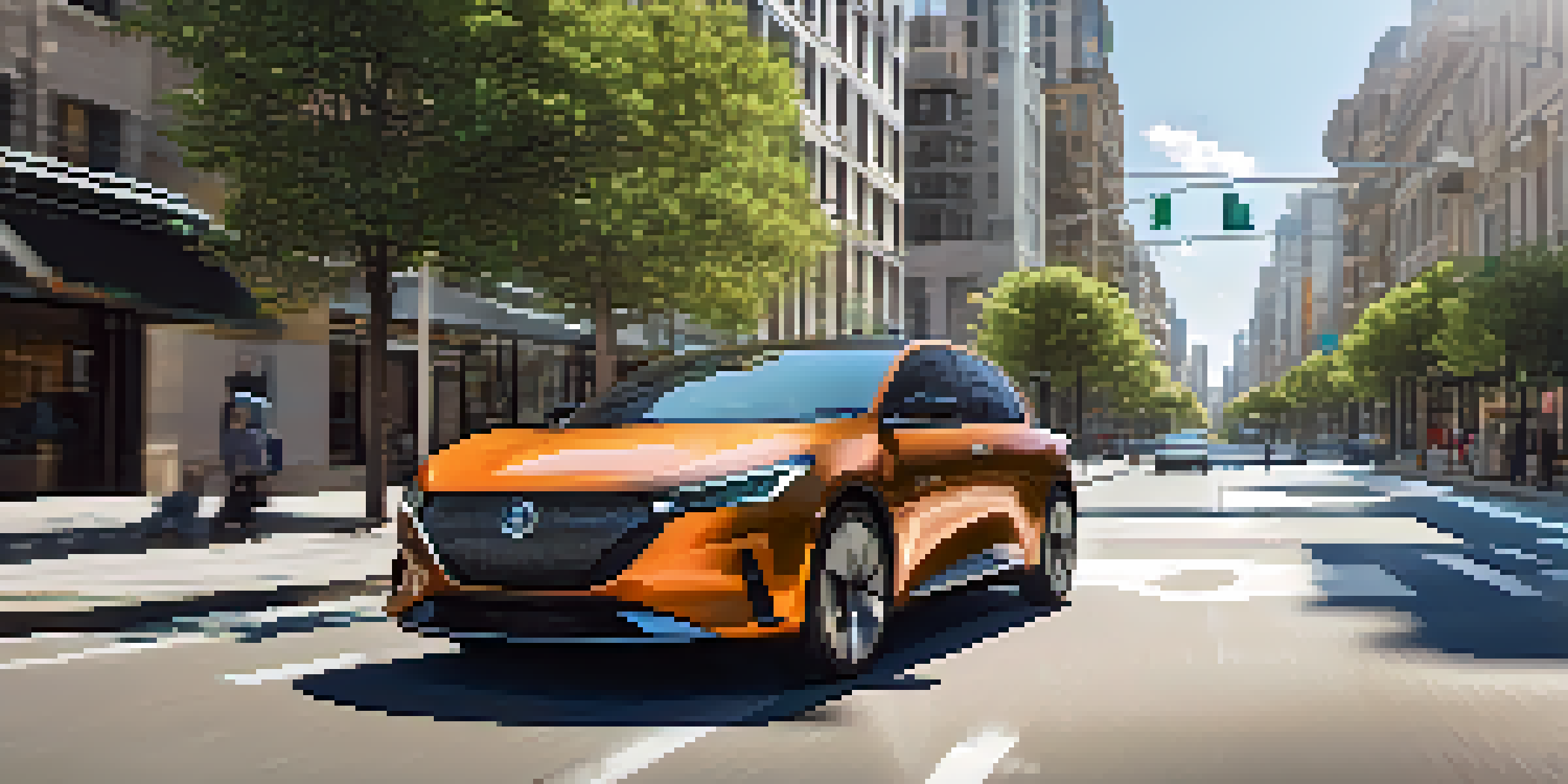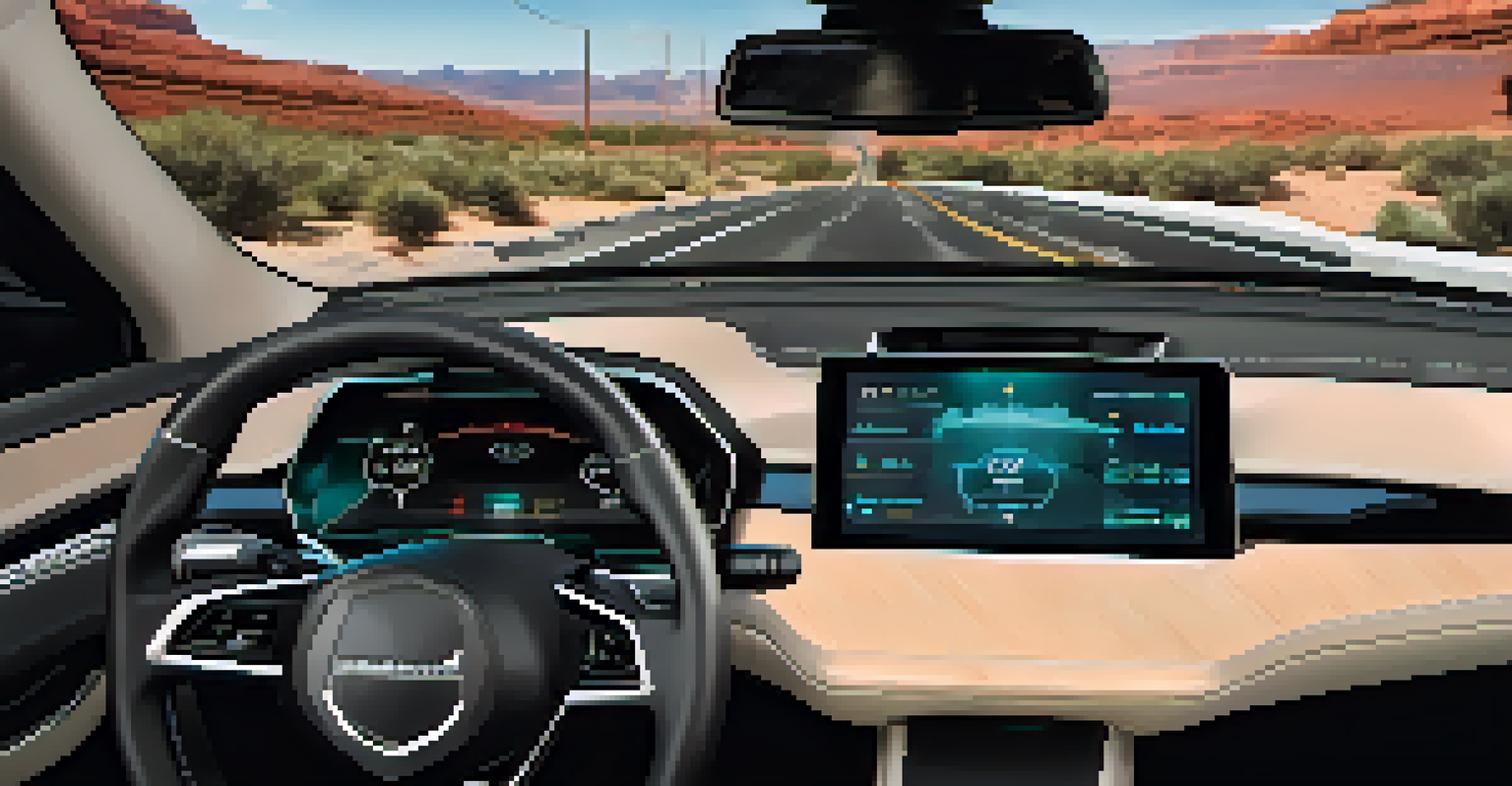How IoT is Shaping the Future of Connected Vehicles

Understanding IoT and Its Role in Vehicles
The Internet of Things, or IoT, refers to the network of devices that connect and communicate with each other over the internet. In the context of vehicles, IoT enables cars to share data with other vehicles and infrastructure, creating a more efficient driving experience. Imagine your car talking to traffic lights or even other cars to optimize routes and reduce congestion—this is the power of IoT.
The IoT is a catalyst for a new era of transportation, where connectivity enhances safety and efficiency on our roads.
With sensors embedded in vehicles, data on speed, location, and fuel efficiency can be continuously collected and analyzed. This real-time data not only helps in improving vehicle performance but also enhances safety by alerting drivers to potential hazards. Just think of it as having a co-pilot who’s always aware of the road conditions and traffic patterns around you.
As IoT technology advances, the integration of smart systems in vehicles will only deepen, leading to a future where connectivity is seamless. This technological evolution is not just about adding features; it's about fundamentally changing how we interact with our vehicles and the world around us.
Enhanced Safety Features Through Connectivity
One of the most significant advantages of IoT in connected vehicles is the enhancement of safety features. Advanced driver-assistance systems (ADAS) can communicate with IoT networks to provide real-time updates on road conditions, accidents, and other hazards. For example, if there's a sudden traffic jam ahead, your vehicle can receive alerts and suggest alternative routes.

Connected vehicles can also utilize vehicle-to-vehicle (V2V) communication, allowing them to share critical information about speed and direction with each other. This level of communication can help prevent accidents by alerting drivers to potential collisions before they happen. Just imagine a scenario where your car warns you about a vehicle that’s about to run a red light—this could save lives.
IoT Enhances Vehicle Safety
The integration of IoT in vehicles allows for advanced communication systems that enhance safety by alerting drivers to potential hazards and providing real-time traffic updates.
Ultimately, the combination of IoT and vehicle technologies means that our cars are evolving into safer, more aware companions on the road. As this technology continues to develop, we can expect even more groundbreaking safety features that will make driving a much safer experience.
Improving Traffic Management with IoT
IoT technology is not only transforming individual vehicles but also how we manage traffic as a whole. By collecting and analyzing data from multiple vehicles on the road, cities can gain insights into traffic patterns and optimize signal timings. This means less time spent idling at red lights and more efficient commutes for everyone.
Connected vehicles have the potential to dramatically reduce traffic congestion and improve the quality of urban life.
For example, smart traffic lights can adjust their timings based on real-time traffic flow, reducing congestion and improving overall traffic management. When cars communicate their locations and speeds, it allows for a more dynamic and responsive traffic control system. Picture a city where traffic jams are a thing of the past—this is what IoT promises.
As urban areas grow, the need for efficient traffic management becomes even more critical. IoT-enabled systems can help cities adapt to increasing vehicle volumes, ensuring smoother traffic flow and a better quality of life for residents.
Fuel Efficiency and Emission Reductions
Another crucial aspect of IoT in connected vehicles is its potential for improving fuel efficiency and reducing emissions. By analyzing driving patterns and vehicle performance data, IoT systems can provide recommendations for more economical driving habits. This not only saves money on fuel but also contributes to a healthier planet.
For instance, connected vehicles can suggest optimal routes that avoid heavy traffic, leading to less fuel consumption and fewer emissions. Additionally, IoT technology can help monitor engine performance in real-time, alerting drivers to issues that may lead to inefficient fuel use. It’s like having a personal coach encouraging you to drive smarter.
Improved Traffic Management
IoT technology enables cities to optimize traffic flow and signal timings by analyzing data from connected vehicles, leading to reduced congestion and more efficient commutes.
As more vehicles become connected, the cumulative effect on fuel efficiency could be significant. By embracing IoT, we can work towards a future where our transportation systems are not just efficient but also environmentally friendly.
The Role of Data Analytics in Connected Vehicles
Data analytics plays a pivotal role in harnessing the power of IoT in connected vehicles. With the vast amounts of data generated by sensors and devices, effective analysis can lead to insights that improve vehicle performance and safety. By understanding how vehicles are used and the conditions they face, manufacturers can develop better products and features.
For example, data collected from various driving conditions can help engineers refine vehicle designs to enhance durability and performance. This feedback loop ensures that cars on the road are continuously improving based on real-world data. Think of it as a constant evolution, where each vehicle learns from the experiences of its predecessors.
Moreover, data analytics can enhance user experiences by offering personalized recommendations based on driving habits. Connected vehicles can suggest maintenance schedules, driving tips, or even entertainment options tailored to individual preferences, making every drive more enjoyable.
Challenges and Concerns with IoT in Vehicles
While the benefits of IoT in connected vehicles are clear, there are also significant challenges and concerns that need addressing. One of the primary issues is cybersecurity; as vehicles become more connected, they also become more vulnerable to hacking and unauthorized access. Ensuring robust security measures are in place is crucial to protect both drivers and their vehicles.
Additionally, there's the concern of data privacy. With vehicles collecting and sharing vast amounts of data, questions arise about who owns this data and how it’s used. Drivers should feel confident that their information is handled responsibly and transparently, which requires clear regulations and standards in the industry.
Fuel Efficiency and Eco-Friendliness
Connected vehicles can leverage IoT to analyze driving patterns and recommend smarter driving habits, resulting in better fuel efficiency and lower emissions.
Navigating these challenges will be essential for the successful integration of IoT in connected vehicles. As the technology evolves, so too must our approaches to security and privacy to ensure that the benefits are realized without compromising safety.
The Future of Connected Vehicles and IoT
Looking ahead, the future of connected vehicles powered by IoT is incredibly promising. As technology continues to advance, we can expect even more innovative features that enhance safety, efficiency, and user experience. From autonomous driving capabilities to smart city integrations, the possibilities seem endless.
Imagine a world where your car can navigate itself through traffic, find parking spots, and communicate with other smart devices in your home. This interconnectedness will create a seamless driving experience, where vehicles are not just modes of transportation but integral parts of our daily lives. It’s like living in a sci-fi movie, where technology simplifies our routines.

As we stand on the brink of this new era in transportation, embracing the potential of IoT will be key. By prioritizing collaboration among manufacturers, policymakers, and consumers, we can shape a future where connected vehicles contribute to safer roads, reduced emissions, and a more efficient transportation system.